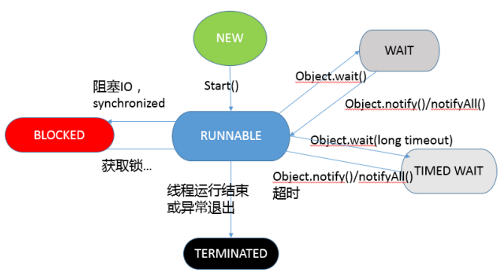Java中线程的生命周期
大家好,我是joker,希望你快乐。
首先说一道常见的面试题,一个线程能不能两次调用start()方法,会有什么效果?
正如大家知道的,答案:不能,线程启动后不能再次启动,会报运行时异常,IllegalThreadStateException
线程是什么?
从操作系统的角度,可以简单的认为,线程是系统调度的最小单元,一个进程可以包含多个线程,作为任务的真正运作者,有自己的栈(stack),寄存器(register),本地存储(thread local)等,但是会和进程内其他线程共享文件描述符,虚拟地址空间。
线程分内核线程,用户线程,Java的线程实现是和虚拟机相关的。Hotspot线程模型是一对一映射到操作系统的内核线程。
守护线程(Deamon Thread):后台线程,不希望其影响应用退出,如果JVM发现只有守护线程,将结束进程。
JDK5以后Java Thread Stack默认为1M
线程各状态说明
接下来线程启动后都有哪些状态?这些状态如何相互转换?
线程生命周期不同状态:可以在java.lang.Thread.State枚举中看到
public enum State { /** * Thread state for a thread which has not yet started. */ NEW, /** * Thread state for a runnable thread. A thread in the runnable * state is executing in the Java virtual machine but it may * be waiting for other resources from the operating system * such as processor. */ RUNNABLE, /** * Thread state for a thread blocked waiting for a monitor lock. * A thread in the blocked state is waiting for a monitor lock * to enter a synchronized block/method or * reenter a synchronized block/method after calling * {@link Object#wait() Object.wait}. */ BLOCKED, /** * Thread state for a waiting thread. * A thread is in the waiting state due to calling one of the * following methods: * <ul> * <li>{@link Object#wait() Object.wait} with no timeout</li> * <li>{@link #join() Thread.join} with no timeout</li> * <li>{@link LockSupport#park() LockSupport.park}</li> * </ul> * * <p>A thread in the waiting state is waiting for another thread to * perform a particular action. * * For example, a thread that has called <tt>Object.wait()</tt> * on an object is waiting for another thread to call * <tt>Object.notify()</tt> or <tt>Object.notifyAll()</tt> on * that object. A thread that has called <tt>Thread.join()</tt> * is waiting for a specified thread to terminate. */ WAITING, /** * Thread state for a waiting thread with a specified waiting time. * A thread is in the timed waiting state due to calling one of * the following methods with a specified positive waiting time: * <ul> * <li>{@link #sleep Thread.sleep}</li> * <li>{@link Object#wait(long) Object.wait} with timeout</li> * <li>{@link #join(long) Thread.join} with timeout</li> * <li>{@link LockSupport#parkNanos LockSupport.parkNanos}</li> * <li>{@link LockSupport#parkUntil LockSupport.parkUntil}</li> * </ul> */ TIMED_WAITING, /** * Thread state for a terminated thread. * The thread has completed execution. */ TERMINATED; }
新建(NEW):线程被创建但是还没有启动
就绪(RUNNABLE):线程已经在JVM中执行,可能正在运行,也可能正在就绪队列中等待系统分配CPU时间片
阻塞(BLOCKED):同步相关,表示线程正在等待Monitor Lock
等待(WAITING):正在等待其他线程采取某些操作
计时等待(TIMED_WAIT):进入条件和等待状态类似,但是调用的是存在超时条件的方法
终止(TERMINATED):线程终止运行,不管是正常执行结束还是意外退出
各个状态之间的转化:

查看JVM运行线程的方式
通过线程组,一直找到最顶级的父线程组
通过jstack
通过MXBean
作者:Crazy_Joker
来源:http://www.cnblogs.com/Crazy_Joker
本文版权归作者和博客园共有,欢迎转载,但未经作者同意必须保留此段声明,且在文章页面明显位置给出原文连接,否则保留追究法律责任的权利。
来源:http://www.cnblogs.com/Crazy_Joker
本文版权归作者和博客园共有,欢迎转载,但未经作者同意必须保留此段声明,且在文章页面明显位置给出原文连接,否则保留追究法律责任的权利。






【推荐】国内首个AI IDE,深度理解中文开发场景,立即下载体验Trae
【推荐】编程新体验,更懂你的AI,立即体验豆包MarsCode编程助手
【推荐】抖音旗下AI助手豆包,你的智能百科全书,全免费不限次数
【推荐】轻量又高性能的 SSH 工具 IShell:AI 加持,快人一步